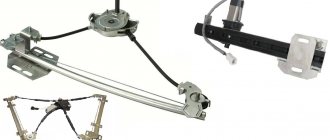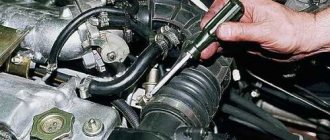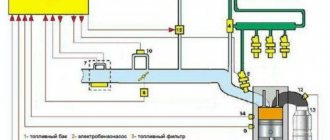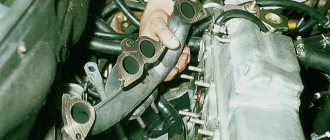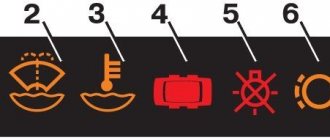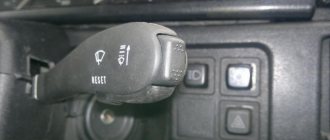Have you encountered engine problems when the car stalls in traffic jams or the engine speed is unstable? There may be several reasons for these malfunctions. It is recommended to start searching for a problem with diagnostics, and if this is not possible, then first perform a check, and only then change the faulty parts.
AvtoVAZ installs the same type of engines on modern Lada cars (Kalina, Granta, Priora, Largus, Vesta, Niva or XRAY), so the solution to problems for all these cars is similar.
The idle speed fluctuates, the engine stalls when moving (on the move) or at a standstill, the reasons may be the following:
- The engine air filter is clogged.
- The spark plugs are faulty.
- High voltage wires are faulty.
- Ignition module/coils are faulty.
- The idle air control (IAC) or its electrical circuits are faulty.
- The throttle position sensor (TPS) is faulty or the throttle assembly is dirty.
- The mass air flow sensor (MAF) is not working.
- The oxygen sensor (OS) or circuits are faulty.
- There is insufficient pressure in the fuel rail.
- Compression in the cylinders is low.
- The exhaust system is leaking.
- Air leaks through the crankcase ventilation hoses and the hose connecting the intake pipe to the vacuum brake booster.
- The cylinder head gasket is damaged.
- The timing belt or tension roller is worn.
- The camshaft cams are worn.
- The valve timing is off. Check the alignment of the marks on the crankshaft and camshaft.
- The engine control unit (ECU) or its circuits are faulty.
Have you encountered floating engine speeds? What was the cause of the malfunction? We solve such engine problems in the comments or on the forum. Let us remind you that along with unstable speed there may be other problems, for example, the engine is difficult to start.
The Lada Kalina idle speed sensor or IAC is a device that is responsible for the necessary air supply to the internal combustion engine when it is idling (in the absence of pressure on the gas pedal). For example, the driver releases the accelerator pedal and the air supply to the internal combustion engine stops. To prevent the engine from stalling, the idle speed sensor comes into operation, which is involved in the process of supplying the required amount of air bypassing the throttle assembly.
In other words, the IAC is a kind of valve-regulator. It is very important for every car owner to know and understand the principles of operation of the product, because if it breaks down, in most cases the car’s self-diagnosis system does not determine the reason for the incorrect operation of the engine.
Where is the IAC located and how does it work?
The Kalina idle speed sensor performs four main functions:
- Maintaining a certain number of engine revolutions.
- Providing conditions for starting the engine in winter at sub-zero temperatures. This means that the IAC can increase the speed so that the engine warms up faster. As operating temperature is reached, the speed gradually decreases.
- Maintaining minimum engine speed when the gas pedal is released. Many motorists underestimate this function until problems with starting and unstable engine operation begin.
- Creation of a fuel-air mixture with the required percentage of fuel and air. This ensures optimal fuel consumption and stable operation of the power plant.
Since the IAC is responsible for supplying air to the cylinders, it is located on the throttle assembly. The regulator on almost all naturally aspirated gasoline engines is located next to the throttle position sensor, and Kalina is no exception.
Operating principle of IAC
When the engine is running without increasing speed, that is, at idle, a minimum volume of air enters the combustion chambers of the cylinders. This occurs regardless of the throttle valve being in the closed position. The volume of intake air consumed is monitored and measured by the MAF (mass air flow sensor), which sends data to the ECU.
Based on the information received, the control unit supplies the required amount of fuel to the cylinders through the injectors. At the same time, the controller monitors the crankshaft speed using its position sensor (DPKV). According to the data obtained, the IAC needle opens or closes, controlling the air supply past the throttle valve, which at this stage is not involved in the operation of the engine.
If the engine has not yet reached the set temperature, the controller uses the IAC to increase the air supply, increasing the crankshaft speed to warm up the power unit faster. Thanks to this mode, the car can start moving almost immediately, without the need to reach operating temperatures.
Technically, the IAC is not a sensor, it is an actuator, so the controller cannot diagnose its malfunction. This means that the “Check Engine” icon will not light up on the instrument panel if the regulator breaks down. In their symptoms, IAC malfunctions are similar to TPS (throttle position sensor) malfunctions. But in the case of the latter, the icon will definitely light up, indicating engine problems.
conclusions
Floating idle speed of the Lada Kalina engine can cause other, more serious problems to appear. So, if such an effect occurs, it is necessary to find the cause and eliminate it. If you can’t do it yourself, you need to contact a car service, where they will quickly find and fix the problem. Repeatedly, due to the constant effect of floating speed, car owners have had to replace the electronic control unit.
Like many people, I had this problem. Believe it or not, I just changed the air filter and everything is fine, everything has been fine since the summer (ugh, ugh, ugh). Only now the fan is soaring and turns on when the engine is cold. Can someone talk to me about this topic?
Source
Functional features
The main purpose of the sensor discussed here in Lada Kalina is to measure the main parameters in the intake system and adjust the speed. This is done by sending pulses to the engine control module, which, based on the data received, adjusts the volume of injected fuel.
Due to the fact that the specified idle speed regulator acts as an actuator, determining its failure is a very difficult task. This is due to the lack of a useful self-diagnosis function in the Lada Kalina.
The device is designed to control the volumes of air that are directed through the intake tract into the combustion chambers of the engine. Here, the air mass (also measured by the mass air flow sensor) enters through a special channel, bypassing the throttle valve, which is closed in idle speed mode.
This idle speed regulator is involved in warming up the 8-valve engine, ensuring that the unit reaches its operating temperature in a timely manner.
When the ignition is turned on, a rod “crawls out” from the regulator and reaches a specially designed hole. This is called the initial position of the sensor.
Next, we outline the primary functions of this device:
- adjusting the optimal air mass;
- participation in warming up the engine 8 valves;
- determination and adjustment of the number of revolutions.
Increased idle speed on engines with a carburetor
At the very beginning, we note that an increase in idle speed on carburetor engines is often associated with the metering device itself. If high engine speeds are noted at idle in the case of a carburetor engine, then there may be several reasons.
- The first reason is a broken idle speed control. This adjustment is carried out using an adjusting screw, which allows you to enrich or lean the mixture. To solve the problem, you must correctly adjust the idle speed on the carburetor.
- You should also pay attention to the fact that the air damper may not open completely on carburetor cars.
- Another place to pay attention is the first chamber choke in the carburetor. The specified damper may not close completely due to defects in the damper itself or an incorrectly adjusted actuator.
- Finally, we add that a noticeable increase in the fuel level may be observed in the carburetor float chamber, which also leads to an increase in idle speed.
Signs of IAC malfunction
Among the signs that directly or indirectly indicate incorrect operation of the idle speed sensor are the following:
- the engine does not start well - it becomes impossible to start the engine without pressing the gas pedal;
- when switching to neutral gear, “dips” in speed and their instability are observed;
- when changing gears, the speed drops or the engine stalls completely;
- the engine does not warm up well at low temperatures, since increased speeds (1500 rpm) are not reached;
- after turning on energy consumers (high beams, heater, air conditioner), the speed begins to “sag” or “float”;
- The engine spontaneously increases and decreases speed.
The IAC cannot be repaired; the device must be replaced. Before changing the idle air regulator, it is advisable to flush the throttle assembly.
How to check the regulator
There are a lot of ways to diagnose ICC. The most effective and simple methods for checking the Kalina idle speed control:
- Routine IAC testing for performance. To do this, the device must be removed from the throttle assembly and the terminal block connected if it was disconnected for dismantling. After this you need to start the engine. At the moment of startup, the needle of a working device should extend. If this is not observed, the regulator is broken.
- Checking the supply of the required voltage to the sensor. You need to disconnect the terminal block from the IAC and connect a voltmeter to the terminals. After this, one person turns on the ignition, and the second measures the resistance at all terminals of the block. If there are no faults, the voltmeter reading should be approximately 50 ohms. The voltage should be at 12 V. If it is significantly less, this indicates a battery malfunction or an electrical circuit break in one of the sections.
- Measuring the resistance of the internal and external windings of the regulator. To do this you need to use a multimeter. The measurement results should not be lower than 40 Ohms and higher than 80 Ohms. If you deviate from the specified range, the idle air control must be changed.
Knowing the signs of problems, you can promptly diagnose IAC malfunctions and take measures to eliminate them. Although the regulator cannot be repaired, it is worth trying to clean it. In some cases this is enough.
Replacing the idle speed sensor
The sensor replacement begins, we dismantle the device.
- We remove the engine screen from the LADA Kalina and disconnect the cable connectors from the corresponding blocks on the throttle unit and the idle speed controller.
- To disconnect the heating pipes, you will need to partially drain the antifreeze. We carry out the indicated manipulations.
- To dismantle the device itself, we need a regular screwdriver with a cross-shaped profile.
- We remove the pipe leading from the crankcase ventilation system. We do this by loosening the clamps and moving them. We are temporarily putting this hose aside.
- We repeat such manipulations with the refrigerant supply pipes (if they have not been previously removed) and the purging of the absorber circuit.
- Using the key set to “13” (the head is more convenient), we remove the throttle block. It is attached to the inlet receiver with nuts.
- Let's look at the gasket. If damage is found, we must replace it, otherwise the intake system will receive unwanted air leaks.
- Installation of the regulator in the LADA Kalina car is also simple and is carried out with an eye to the reverse sequence of manipulations during disassembly.
- It is important to pre-measure the needle here. The optimal position will confirm the exit from the regulator body to a length of at least 23 mm. For measuring action we use a caliper. If the required value is not achieved, then you will need to “recess” the valve itself into the regulator body. Here we connect the positive contact of the device to the corresponding terminal of the battery (you will need a temporary cable).
We apply the bare edge of the element to the negative contact. The needle moves slowly, and therefore quite a lot of such touches will be required.
IAC cleaning
Place the idle speed sensor on a clean rag and spray the idle speed sensor needle with cleaning fluid from an aerosol can. While spraying, be careful not to get any liquid under the spring. If this happens, you will need to purge the sensor under high pressure, but this procedure will not guarantee that the IAC will work correctly. Next, wipe the needle with a clean piece of rags and wait until it dries completely.
Idle speed sensor on Lada Kalina - the photo shows the cleaning process
If this is not done, you will subsequently have to dry and clean the car spark plugs. Use engine oil and wipe the idle speed sensor O-ring. After that, install it in the seat and securely fasten it with two screws.
When installing the sensor, care must be taken, since the IAC will not operate normally with a damaged seal. If after cleaning the idle speed sensor does not want to function normally, it must be replaced with a new one.
Replacing the idle air control
To do the job you only need a shaped screwdriver. If dismantling involves removing the entire throttle assembly, you need to prepare a set of standard socket wrenches or sockets.
- First, wait until the engine has cooled down, after which you can disconnect the terminals from the battery.
- The clamps must be removed from all hoses.
- From the idle speed control and throttle position sensor, disconnect the wire chips and remove the throttle cable.
- The throttle heating hoses must be removed and plugged.
- Use a 13mm wrench to unscrew the fastening nuts, then the throttle assembly can be removed.
- Next, all that remains is to unscrew the two screws holding the idle speed control and remove it. A new IAC is installed in its place and secured with two screws.
You should not touch, much less move, the sensor rod - such manipulations can lead to failure of the device. If, after starting, increased engine speeds are observed (more than 1500 rpm), then there is nothing to worry about. If such a situation occurs, you need to turn off the engine and start it again - the position of the IAC valve will be calibrated and the speed will return to normal.
The throttle assembly is installed in the reverse order of removal. If cleaning of the damper is not required, the sensor can be replaced without dismantling the unit. When tightening all nuts, be careful not to loosen the fasteners. Otherwise, the sensor will vibrate when the engine is running and will quickly become unusable.
During operation of the car, you need to periodically check all its systems and mechanisms, diagnosing possible malfunctions in the early stages. IAC Lada Kalina should also be tested occasionally. The needle and, in general, the entire throttle assembly should not be allowed to become heavily contaminated.
At the slightest disturbance in the stability of the engine, it is necessary to carry out a thorough check and eliminate all possible malfunctions. Only in this case will the car work reliably and for a long time.
The idle speed regulator is a device that is necessary in the system to stabilize the idle speed of the engine.
While the engine is idling, by changing the flow area of the additional air supply channel, bypassing the closed throttle valve, the amount of air necessary for its stable operation enters the engine. This air is taken into account by the mass air flow sensor (MAF) and, in accordance with its quantity, the controller supplies fuel to the engine through the fuel injectors.
Using the crankshaft position sensor (CPS), the controller monitors the number of engine revolutions and, in accordance with the engine operating mode, controls the idle speed regulator, thus adding or reducing the air supply bypassing the closed throttle valve.
When the engine is warmed up to operating temperature, the controller maintains idle speed. If the engine is not warmed up, the controller increases the speed using the idle speed regulator and, thus, ensures warming up of the engine at increased crankshaft speeds.
This operating mode allows you to start driving the car immediately without warming up the engine. The idle air control is an actuator and its self-diagnosis is not provided for in the system.
Therefore, if the idle speed control malfunctions, the “CHECK ENGINE” lamp does not light up. Symptoms of malfunctions of the idle speed controller are in many ways similar to malfunctions of the TPS (throttle position sensor), but in the second case, most often the “CHECK ENGINE” lamp clearly indicates a malfunction of the TPS.
The following symptoms can be attributed to malfunctions of the idle air regulator:
unstable engine speed at idle, spontaneous increase or decrease in engine speed, engine stopping when the gear is turned off, lack of increased speed when starting a cold engine, decrease in engine idle speed when a load is turned on (headlights, heater, etc.).
IAC calibration procedure?
1. Before installing the IAC, it is necessary to disconnect the terminal (de-energize the computer) 2. When installing the IAC, the distance between the end of the IAC needle and the mounting flange should be no more than 23 mm. 3. After installation, connect the battery terminal. 4. Turn on the ignition (without starting the engine) for 5-10 seconds. (At this moment, the ECU is calibrating the IAC) 5. Turn off the ignition. (Calibration completed.) 6. Start the engine, check the operation of the IAC.
If the terminal is not disconnected, then the ECU does not perform any calibration!
The IAC performs two main tasks:
- When the engine starts up, the idle air valve helps it reach the required number of revolutions.
- When you are moving in “neutral”, switching gears, are cranked up and are just about to start – the idle speed regulator maintains the speed at the required level, does not allow it to “jump” and stall the car.
How does the idle air valve work?
Without going into details, which are not really necessary for a simple car owner, the idle air control works according to the following principle:
When the engine is idling, it receives a certain amount of air. The crankshaft sensor takes into account the number of revolutions and supplies data to the control unit, which, in turn, already issues IAC commands.
The valve increases or decreases the amount of incoming air, regardless of the throttle position. By the way, the sensor is located in its body.
As for cars with a carburetor engine, they are equipped with a slightly different idle speed control system. Manual configuration is required there. If you have certain skills, knowledge and experience, you can adjust the idle speed simply by turning special screws. If you are not sure of the correctness and accuracy of your actions, it is better to entrust this work to the specialists at the service station.
Like any other part of the car, the idle air control has a “habit” of wearing out, breaking down, and malfunctioning.
At the slightest malfunction, the IAC will immediately make itself known, or rather, the sensor will report this to the computer, and it, in turn, will show that something is wrong in the car. This must be approached with full awareness of the problem and responsibility. Under no circumstances should you operate a vehicle with a broken sensor, or with obvious signs indicating a failure of the idle air regulator. But a big problem may be that the IAC does not show any specific signs of its malfunction. Symptoms can be completely different and similar to failures of other parts.
What could cause the breakdown? There are a lot of options here, but the most common are these three:
- The wire in the sensor itself has broken;
- Due to the long period of active use, the guide needles have worn out;
- The rod is clogged.
Is there a knocking noise in the rear suspension?
This material will help you understand the reasons. The main signs of failure of the idle speed sensor:
- The car starts without problems, but literally after a couple of minutes it stalls. This is repeated regularly.
- The revolutions “jump” like crazy.
- When you turn on the air conditioner, heater or additional lighting sources, the idle speed drops sharply.
- The car stalls while changing gears.
- When the engine is cold started, the number of revolutions is minimal, or even zero.
- The engine is clearly "troubling" at idle
Consequences of inaction
Prolonged ignoring of any manifestations of idle air control malfunctions is detrimental to your car’s engine.
By postponing the diagnosis and solution of the problem, you yourself are bringing the “death” of the engine closer. “Resuscitation” can cost a very large and round sum. And driving during this period will not be the most pleasant experience, but on the contrary, a complete headache and complete disappointment. Each attempt to start the car will last at least ten to fifteen minutes.
If you notice at least one of the above signs, then you don’t need to start panicking and run to buy an idle air control sensor. The same signs can signal other malfunctions in the car’s engine. First you need to make sure that the problem is in the IAC. Contact the service station. There your car will undergo a full diagnostic.
The most basic and relatively quick way to check is to temporarily replace the installed sensor with another working one. It is very important that the sensor itself is of high quality. Nowadays it is very easy to run into a fake, remember the saying about the one who pays twice? Prices for IAC vary from five hundred rubles and above.
If the “symptoms” have not disappeared, then the problem must be looked for more carefully in other engine parts.
Idle air control malfunctions and how to fix them
A complete computer diagnostic will detect problems with the idle air control and display an error alert. Most often the problem is an open circuit. It is diagnosed using a multimeter.
Another common failure of the IAC is rod clogging and jamming. This happens because when driving, moisture, liquid, dust, dirt, and debris get there. This causes it to clog or rust.
Sources
- https://kalina-2.ru/remont-vaz/priznaki-neispravnosti-rhh-kalina
- https://Vaz-Lada-Granta.com/kalina/elektrika-i-tormoz/regulyatora-holostogo-hoda.html
- https://inomarki-remont.ru/datchik-holostogo-hoda-lada-kalina.html
- https://carfrance.ru/pochemu-plavayut-oboroty-na-xolostom-xodu-lada-kalina-prichiny/
- https://carfrance.ru/dvigatel-na-lada-kalina-rabotaet-s-pereboyami-na-xolostom-xodu-pochemu/
Lada Kalina revs float
Lada Kalina 2. Engine speed jumps at idle
Engine speed jumps (floats)
Floating idle speed is a fairly common malfunction on various cars. The revolutions fluctuate on gasoline cars and diesel units, as well as on engines with gas equipment. Note that the idle speed on gas or gasoline fluctuates quite often due to third-party incorrect ECU firmware. While driving, this problem can cause a lot of inconvenience, since the driver is forced to constantly apply gas to prevent the engine from stalling at the most inopportune moment. Next, we will look at why the engine speed jumps at idle, as well as how to determine the cause of the problem for further elimination.
Unstable idle speed: reasons
Normally, idle speed on different engines can fluctuate in the range from 700 to 900 rpm. It should be taken into account that immediately after starting a cold internal combustion engine, the control unit increases the idle speed, forcing the engine to operate in the so-called “warm-up mode”. This mode is normal, that is, it is not a malfunction. After reaching a certain temperature and slightly warming up the engine, the “warm-up” speed drops, and the engine begins to operate in normal idle mode.
If the engine speed jumps at idle, then this malfunction looks like lightly pressing and releasing the gas pedal, and the driver himself does not press the accelerator. In other words, the idle speed may be too high or normal, then begin to drop to the point where the engine almost stalls. After this, the engine “picks up” again, the needle on the tachometer rises again and the jumps in the form of increasing and decreasing speed are repeated. Typically, the malfunction appears for several minutes, often on a cold engine, after which it disappears until the next start. It is also possible that the breakdown is present constantly and regardless of the degree of engine warm-up, that is, the speed constantly fluctuates after the gas pedal is released and the internal combustion engine switches to idle mode.
There are many reasons for such unstable idle. Among them there are several main ones. First of all, it is necessary to take into account the type of engine installed and its power system: carburetor, injector, diesel engine.
On engines with a carburetor, most problems are solved by cleaning and adjusting the specified metering device.
The engine idle speed on the carburetor must be adjusted, since the settings tend to get lost during active operation of the vehicle. You should also pay attention to ensure that the fuel-air mixture does not become significantly depleted in the carburetor. The carburetor solenoid valve deserves special attention. A characteristic sign of its breakdown is the engine’s refusal to idle without choke. It is also necessary to exclude the possibility of air leaking into the carburetor, which can also greatly lean the mixture. As a result, the engine stalls, the speed jumps, and the engine begins to stall. When manipulating the carburetor, you should check the degree of contamination of the jets, clean the idle passages, assess the fuel level in the float chamber, etc. The ultimate goal is a normal supply of air and fuel to the carburetor, as a result of which the mixture composition will be optimal for the idle mode. During operation, carburetor jets require periodic cleaning; at the same time, you need to check the condition of the air filter and replace a heavily contaminated element.
Now there are several reasons why the speed jumps on an injection engine. As you know, modern cars with such an engine are equipped with electronic fuel injection controlled by the ECM. Such a control system is structurally equipped with many sensors, thanks to which the composition of the fuel mixture is determined in different operating modes of the internal combustion engine. It is quite obvious that failure or erroneous data from any sensor can lead to floating idle speed. In other words, the electronic control unit (ECU) does not receive reliable information or receives data intermittently, resulting in the speed jumping at idle. The list of possible malfunctions should include:
Ignition and problems with this system. It is necessary to check high-voltage wires, spark plugs and other elements. Inlet. Malfunctions in the intake may be associated with the mass air flow sensor, a dirty air filter, or air leaks. Idle speed regulator. Failure or malfunction of this device naturally leads to unstable engine speed at idle. Exhaust gas recirculation system USR. Problems with EGR cause disturbances in the composition of the fuel-air mixture, which also affects the stability of engine speed. If the speed fluctuates at idle, then checks should begin with the IAC. The location of the regulator is usually the area next to the throttle position sensor TPS. You can check the specified device by replacing it with a known good one or using a multimeter. To check with a multimeter, you should find out the operating resistance, and then measure the resistance of the regulator with a tester. Deviations from the norm will indicate a possible breakdown of the idle air regulator.
If the regulator diagnostics show its operability, then the test should be continued. The next element is the mass air flow sensor DMRV. To check, you should disconnect the power connector from the mass air flow sensor, after which you need to start the power unit. In idle mode, the speed can rise to about 1200-1500 rpm. Stable operation of the internal combustion engine with the mass air flow sensor disabled and improved acceleration dynamics while driving will indicate that the speed may fluctuate due to problems with the mass air flow sensor.
As for the EGR valve, this solution allows some of the exhaust gases to be returned back into the intake. This was done to improve the environmental performance of the internal combustion engine. In other words, the valve opens and then closes the passage to send exhaust back into the engine. Failure or “sticking” of the valve leads to excess exhaust gases entering the intake, affecting the mixture composition, idle speed and other engine operating modes. For normal operation, the EGR valve must be cleaned periodically, especially its seat. A diesel engine is structurally different from a gasoline engine in that it contains a fuel injection pump. For this reason, floating idle speed can occur both as a result of problems inherent in gasoline analogues, and as a result of problems with the high-pressure pump. For example, corrosion or mechanical wear of moving elements inside the pump. Jams and other failures lead to the idle speed of a diesel engine jumping.

